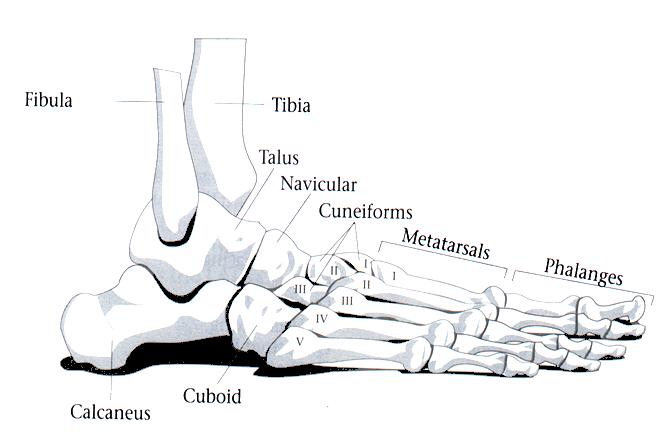
The Foot And Ankle
More than 14.2 million visits were made to physicians’ offices in 2001 because of foot, toe and ankle problems, including 2.3 million visits for ankle sprains and 1.2 million visits for ankle fractures. Consider this:
How do the foot and ankle work?
Here are some facts from the American Academy of Orthopaedic Surgeons: Each foot has 26 bones. The ankle bone (talus) and the ends of the two lower leg bones (tibia and fibula) form the ankle joint, which is stabilized and supported by three groups of ligaments. Muscles and tendons move the foot and ankle.
Lateral View of the Right Foot
Medial View of the Right Foot
What are the most prevalent foot and ankle injuries?
What activities make people most susceptible to foot and ankle injuries?
Athletes who jump risk ankle sprains because they can accidentally land on the side of their foot. Extensive running, exercise, or training also can overstress the ligaments, leading to injury. Contact and kicking sports expose the foot and ankle to potential trauma—direct blows, crushing, displacement, etc. Especially prevalent in football, hockey, and soccer—trauma can dislocate a joint, fracture a bone, stretch or tear ligaments, or strain muscles and tendons.
What other factors make people susceptible to foot and ankle injuries?
Improperly fitting shoes or improper footwear for a particular sport can damage your feet. Training errors, i.e., running up hills, or running on bumpy roads, predispose you to serious sprains and strains. If you start a new sport without proper conditioning, you are at risk.
How are foot and ankle injuries treated?
Most sprains and strains are initially treated with rest, ice, compression, and elevation. Moderate and severe sprains and strains are often immobilized with a cast or splint. Severe fractures often require surgical repair.
No one is immune from these injuries, but the American Academy of Orthopaedic Surgeons developed these tips to help reduce your injury risk:
Warm up before any sports activity, including practice
Participate in a conditioning program to build muscle strength
Do stretching exercises daily
Listen to your body: never run if you experience pain in the foot or ankle.
Wear protective equipment appropriate for that sport
Replace athletic shoes as soon as the tread or heel wears out
Wear properly fitting athletic, dress, and casual shoes